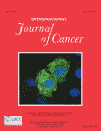Screening for family members of patients with nasopharyngeal carcinoma
Abstract
Nasopharyngeal carcinoma (NPC) is well known for its peculiarly skewed distribution with highest incidence in Southern Chinese population. Familial aggregation is evident, hence screening for early detection is offered by oncology centers in Hong Kong to first-degree relatives of patients with NPC. During the period 1994–2001, 929 family members were screened in our center. The screenees were advised to attend an annual examination that includes serological test against Epstein Barr Virus (EBV), physical examination to exclude cervical lymphadenopathy and cranial nerve palsy, and endoscopic examination of the nasopharyngeal region. Two different methods were used for the serology test: indirect immuno-fluorescent (IF) test for IgA against viral capsid antigen; and starting in 1997 enzyme-linked immunosorbent assay (ELIZA) against nuclear antigen and viral capsid antigen. Twelve cases of nasopharyngeal carcinoma were diagnosed, giving a detection rate of 5/1,155 (433/100,000) person-year for male and 7/1,404 (499/100,000) person-year for female participants observed. The corresponding average annual incidence in Hong Kong during this period was 24.1 and 9.6 per 100,000, respectively. Forty-one percent of these detected cases had Stage I disease, whereas only 2% of patients referred to the department for primary treatment presented with such early disease. Six cases were detected at first visit, and all were EBV-positive. Another 78 screenees with positive serology at first visit were followed up for 204 person years, and thus far NPC was detected in 3 after an interval of 6–32 months. Of the 845 initially EBV-negative screenees followed up for 2,337 person-years, NPC was detected in 3 after an interval of 12–45 months. One showed sero-conversion at the time of diagnosis. We conclude that family members of known patients do show a substantially higher risk of developing NPC, and regular screening by current method improves the chance of early detection. © 2004 Wiley-Liss, Inc.




